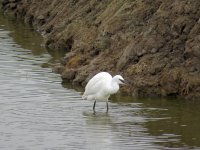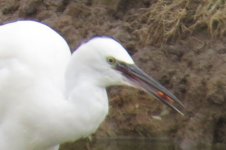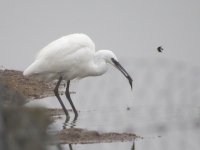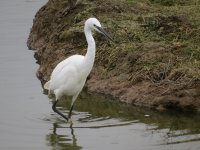So espoused the well-know conservationist and corporate vulture Gordon Gekho in Wall(creeper) Street. What Mr Zeta-Douglas-Jones forgot to add in the excitement of another billion dollar deal was the caveat "in the right circumstances".
I wouldn't want anyone following this thread to think we had a downer on phragmites at Upton Warren. The reed-beds form a vital element of the reserve's bio-diversity, contributing healthy breeding populations of Reed Warbler, Sedge Warbler and Reed Bunting, wintering Bitterns, passage Marsh Harrier and Spotted Crake and one of the best places in the country to actually see Water Rail. Much of the management work of the Tuesday work parties at the Moors Pool focuses on the preservation and improvement of the reed beds - the sectional cutting to promote fresh vibrant growth, the digging of new channels to keep the beds wet, the removal of encroaching willow and alder to prevent the beds drying out, the resculpting of the North Moors etc.
However the Flashes is a different proposition. The historic reedbeds at the Hen Pool also hold good numbers of breeding water and I would look to improve this area this autumn by adopting a similar rotational cutting management scheme as the Moors Pool. The first, second and Flashes though present a near unique habitat of inland brine pool and the salinity of the water has promoted the growth of a number of salt tolerant / salt loving plants and historically inhibited the growth of substantial vegetation on its perimeter, giving rise to both a wide muddy margin suitable for passage and breeding waders and good lines of sight to prevent raptors or mammalian predators popping up close to feeding, nesting birds, plus areas of short grass close to the water's edge suitable for breeding Redshank and Lapwing.
In recent years the reed-beds have spread and merged at the Flashes at an incredible rate, putting pressure on both breeding and feeding birds. The reduction in available shoreline has meant that the waders now congregate in the central areas, bring passage and breeding birds into conflict; gone are the days that one may see ten plus Green Sandpiper strung out along the far shore during their summer movement. Those family parties (especially Avocet) who are forced to the reed-fringed shores through weight of numbers suffer a much higher mortality rate than those broods raised in the prime central areas.
There are several potential ways to manage the situation to preserve this habitat:
(1) Do Nothing - a lack of intervention will see the continued spread of the reedbeds to finally encircle the first and second Flash. This will deter waders from feeding in the rear channel, focussing all the attention on the area directly in front of the hide. It is likely that we would be left with an aggressive colony of breeding Avocet and little else. Our survey of the existing reedbeds show that they hold little in the way of breeding warbler (save the Hen Pool) so there isn't even a silver lining there.
(2) Grazing - the use of Dexter cattle over the last 12 months has certainly improved the quality of the grasslands at the Flashes, stimulating the growth of juncas and creating a number of wet areas ideal for breeding Snipe, Redshank and Yellow Wagtail. However their impact on the phragmites (either existing reeds for fresh growth following cutting) seems negligible, possibly due to the abundance of nice tasty grass, whilst they have had a detrimental effect of breeding birds as they wander across the second Flash. What is unknown is whether another grazing animal, such as Konik ponies, would have more of an impact.
(3) Cutting - for the last couple of year both the Flashes's work parties and the Trust's roving volunteers led by John Hodson have been cutting the reeds in an attempt to limit their growth. Even when these cuts have been timed to coincide with the hard and prolonged winter frosts there appears to have no impact (other than reducing the height to see into the third Flash and grassland beyond); indeed my personal observation is that cutting seems to stimulate the phragmites' growth and spread.
(4) Treatment - the targeted treatment of the phragmities with a chemical herbicide such as glyphosate could eliminate the reedbeds with the agent being carried into the rhizome system beyond the reedbeds themselves. This proposal has been previously opposed by Natural England due to the potential adverse impact on the salt loving / salt tolerant flora.
(5) Removal - a solution that has been considered in the past has been the digging out of all affected areas; given the extent of the rhizomes system this would have to extend to removal of land beyond the extent of the current reedbeds. If done extensively and effectively enough it could remove the problem; the downside is that it would be very expensive, require large machinery and high levels of disturbance and would then necessitate the regarding of the shoreline so we are left with shallow shelving areas for waders to feed rather than a deep trench at the water's edge
(6) Covering - this could be achieved through the use of tarpaulin and similar or a chemical foam once the reeds are cut; a comparable approach has been adopted in the management of the crassula at the Broadmeadow. There are a number of disadvantages: it is unsightly, the treatment would also impact on the salt tolerant / loving plants and the covering of a much wider area than just the current extent of the reedbeds given the extensive spread of the rhizomes. Likewise given the amount of energy stored in the rhizomes this solution would need to remain in place for at least a year.
(7) Realign the water level - it has been mooted that the water level should be dropped at the Flashes to counter ongoing subsidence. This would have the short term benefit to creating a revised shoreline free of phragmites. However this would result in a reduced perimeter and within a few years the reeds would march forward to meet the new waterline
Clearly none of the above options are ideal and it is very much "the lesser of seven evils"; time for some serious and difficult thinking. Unfortunately we don't have too much time as the point of the no return is fast approaching (as the non-appearance so far of LRP indicates).









